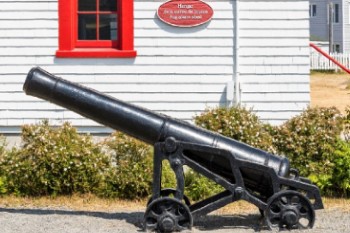
© Claveau Fund, HR — 13238, Musée régional de Rimouski
The fog alarm—from cannon fire to the electronic sound signal
Pointe-au-Père Lighthouse National Historic Site
Whenever weather conditions reduced visibility at sea, the lighthouse keeper had to replace the usual visual signal (i.e., the beacon) by a sound signal. The Pointe-au-Père lighthouse played an important role in testing different types of sound signals, which were subsequently implemented in other Canadian lighthouses.

The first sound signal used at Pointe-au-Père was produced by a cannon, which the keeper had to load with gunpowder and fire every half hour.
The cannon signal was replaced by explosive bomb signals (1894 to 1903), and then by a Scotch siren fog signal (1903). A diaphone, a kind of giant compressed air whistle operated by a fog alarm, was implemented in 1904. Finally, in 1972, this system was replaced by an electronic sound signal, which was used until the Pointe-au-Père navigational aid centre closed in 1997.
The main alterations made to the Pointe-au-Père fog alarm shed today continue to bear witness to this history of experimentation. A semicircular rail behind the building allowed the horn to be oriented depending on wind direction.
- Date modified :